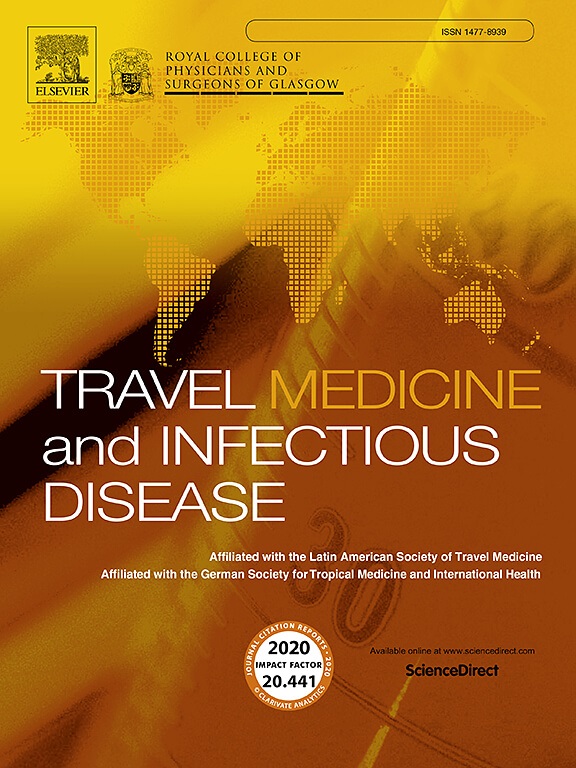Hemorrhagic fevers caused by South American Mammarenaviruses: A comprehensive review of epidemiological and environmental factors related to potential emergence
IF 4.7
3区 医学
Q1 INFECTIOUS DISEASES
引用次数: 0
Abstract
South American hemorrhagic fevers (SHF), a group of zoonotic diseases caused by various virus families including Arenaviridae, Bunyaviridae, Filoviridae, and Flaviviridae, are primarily confined to geographic areas where their host species reside. Transmission to humans occurs through direct contact with infected animals, especially rodents, and when infected, humans can transmit diseases to other humans through person-to-person interactions and other means, leading to illnesses that range from mild to life-threatening conditions. Diseases such as Argentine hemorrhagic fever, caused by the Junin virus, Brazilian hemorrhagic fever, caused by the Sabia virus, Venezuelan hemorrhagic fever, caused by the Guanarito virus, and Chapare hemorrhagic fever, are responsible for most hemorrhagic fevers excluding hemorrhagic consequences of diseases such as those caused by dengue. These diseases were first described in the late 1950s, coinciding with environmental and agricultural changes that led to increased rodent populations and the expansion of urban areas into rural zones. Pathogenically, these viruses typically initiate infection in the lungs and subsequently disseminate to regional lymphatic vessels and other organs, resulting in severe vascular and coagulation dysfunction. Clinical manifestations start with a prodromal phase characterized by general malaise and fever, progressing to more severe neurological and hemorrhagic symptoms, and concluding with a convalescent phase that may result in long-term neurological conditions. We comprehensively reviewed the literature on these South American hemorrhagic fevers. The dynamics of these diseases highlight the complex interactions between environmental factors, human behavior, and viral pathogenicity that drive the epidemiology of hemorrhagic fevers in South America.
由南美乳头状病毒引起的出血热:与潜在出现相关的流行病学和环境因素的综合综述。
南美出血热(SHF)是由沙粒病毒科、布尼亚病毒科、丝状病毒科和黄病毒科等不同病毒科引起的一组人畜共患疾病,主要局限于其宿主物种居住的地理区域。人类通过与受感染动物,特别是啮齿动物的直接接触而传播,并且当受感染时,人类可以通过人与人之间的相互作用和其他方式将疾病传播给其他人,导致从轻微到危及生命的疾病。由朱宁病毒引起的阿根廷出血热、由萨比亚病毒引起的巴西出血热、由瓜纳里托病毒引起的委内瑞拉出血热和查帕雷出血热等疾病是造成大多数出血热的原因,但不包括由登革热等疾病引起的出血热。这些疾病最初是在20世纪50年代末被描述出来的,当时环境和农业发生了变化,导致啮齿动物数量增加,城市地区向农村地区扩张。在致病性上,这些病毒通常在肺部开始感染,随后传播到局部淋巴管和其他器官,导致严重的血管和凝血功能障碍。临床表现始于以全身不适和发热为特征的前驱期,发展为更严重的神经系统和出血性症状,并以可能导致长期神经系统疾病的恢复期结束。我们全面回顾了这些南美出血热的文献。这些疾病的动态突出了驱动南美出血热流行病学的环境因素、人类行为和病毒致病性之间复杂的相互作用。
本文章由计算机程序翻译,如有差异,请以英文原文为准。
求助全文
约1分钟内获得全文
求助全文
来源期刊

Travel Medicine and Infectious Disease
PUBLIC, ENVIRONMENTAL & OCCUPATIONAL HEALTH-INFECTIOUS DISEASES
CiteScore
19.40
自引率
1.70%
发文量
211
审稿时长
49 days
期刊介绍:
Travel Medicine and Infectious Disease
Publication Scope:
Publishes original papers, reviews, and consensus papers
Primary theme: infectious disease in the context of travel medicine
Focus Areas:
Epidemiology and surveillance of travel-related illness
Prevention and treatment of travel-associated infections
Malaria prevention and treatment
Travellers' diarrhoea
Infections associated with mass gatherings
Migration-related infections
Vaccines and vaccine-preventable disease
Global policy/regulations for disease prevention and control
Practical clinical issues for travel and tropical medicine practitioners
Coverage:
Addresses areas of controversy and debate in travel medicine
Aims to inform guidelines and policy pertinent to travel medicine and the prevention of infectious disease
Publication Features:
Offers a fast peer-review process
Provides early online publication of accepted manuscripts
Aims to publish cutting-edge papers
 求助内容:
求助内容: 应助结果提醒方式:
应助结果提醒方式:


